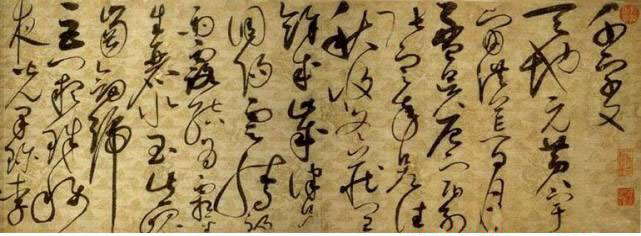The secret of collecting and releasing cursive script

Kuang cursive calligraphy is a highly exaggerated line art form. Understanding, mastering, and skillfully applying the rules of retracting and retracting are very important to create successful cursive calligraphy works. Mr. Yu Youren, a famous modern cursive calligrapher, said that "'Kangcao' is a work of art in cursive calligraphy." This article only discusses the connotation of the expansion and expansion of Kuang cursive script as follows.
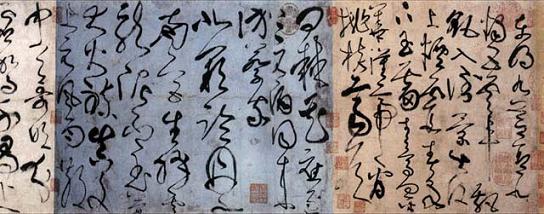
1. The collection and release in character design
Creating shapes based on characters is an important rule in the creation of calligraphy art. Kuang cursive script particularly emphasizes the application of the rules of designing shapes based on characters in creation. Under the premise of being subordinate to and serving the overall beauty of a work, each word appears as a point in the overall beauty. The closing and opening of this point depends on its location, that is, the stage of expression. If it is the stage of rising, the main focus is on retraction; in the stage of inheritance, the main focus is on gradual release; in the stage of transition, the main focus is on release; in the stage of closing, the main focus is on higher-level retracting and releasing interactions, and pay attention to the interaction with the rising stage. The stages echo each other and cannot be independent of each other.
Of course, this is a general criterion for applying the rules of character design. Specific to a work, even the same character's closing and opening performance at each stage will be very different. This wide variety is not due to changes in the law itself, but because of changes in the author's thoughts and feelings, body, age (subjective factors), pen, ink, paper and inkstone, and environment (objective factors), which change the process of character design. The relationship has changed. It can be seen that the changes in the glyph structure are dynamic and absolute, while the law of expansion and contraction is stable and relative.
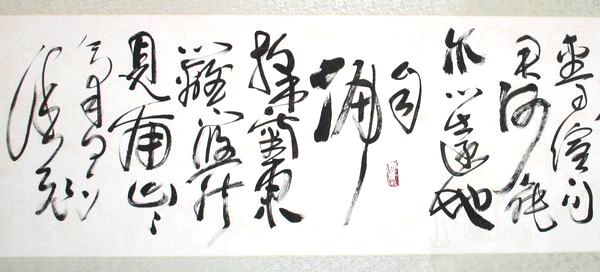
2. Collection and release in an ink unit
One ink unit is the space and time between the words written by the brush once and the next time. (When I write hard pen works, in order to change the ink method and fully express the feelings in my heart, the pen is pumped with water and dipped in water from time to time. But there is no need to bend the pointed pen in advance. I think that is not conducive to change and easy. Losing the inherent rigidity of the pen itself.) An ink unit is a part of the entire work; for this unit, it is a global. The closing and opening of calligraphy express the language, style, interest, rhythm, rhythm and characteristics of the cursive calligrapher. Therefore, the expansion and expansion of every word, every line, and every group of lines (that is, calligraphy language, also called vocabulary) must first obey the local overall situation, and then the expansion and expansion changes within this part. Light and heavy, light and heavy, empty and real, empty and real, long and short, long and short, left and right, left and right, dry and moist, black and white, etc., or go down with the trend, or go backwards, "Indulge in singing high, "Freedom to change" is unexpected and reasonable.
The expansion and expansion of one ink unit must be inherited, changed, contrasted, and developed with the expansion and expansion of the previous ink unit. It must also be different from the expansion and expansion of the left and right ink units, and must live in harmony with them and prosper together. A win-win combination. Whether you can handle the retraction and expansion of each ink unit well is a key link that determines the success or failure of the entire work. Sometimes the contraction and expansion of an ink unit is used to pave the way for expression; sometimes its contraction and expansion is manifested as the state of emotions; sometimes its contraction and expansion is the result of an emotional explosion. It can be seen that the tasks of each ink unit are different, so the starting and ending parts of their expansion and expansion should not collide, so as to form a contrast and balance of the relationship between the ink color expansion and expansion, and naturally produce visual impact of the beauty of staggered, emotional and rhythmic. , beautiful rhythm and beautiful form. For this reason, the ink content and ink color of each ink unit can be different (this involves the use of ink and paper methods, which will not be discussed here). Even if the ink content is the same, the number of words written should not be equal, and the weight, size, etc. should not be repeated. Keep the changes between ink units different and integrated into one. Seek unity in each uniqueness, seek richness in unity, and then achieve the ideal state of the collection and release of an ink unit. It can be said that love brings ink into thousands of colors, and God makes the pen turn into thousands of styles. -
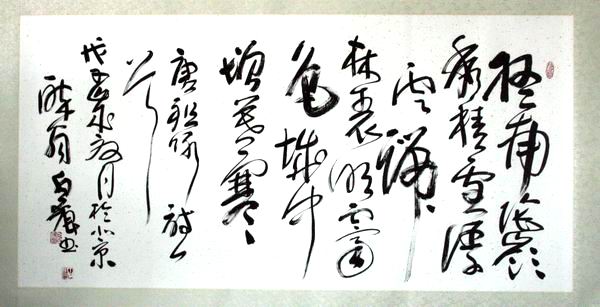
3. The collection and release of Qi
The movement of qi refers to the overall artistic effect of a line's momentum, charm, and mood. The expansion and contraction of Qi is quite like the cadence when a person speaks a sentence, and the length, high and low, and speed when a person sings a song are the natural traces of the author's thoughts, feelings and artistic skills, rather than being designed in advance. Machine made. Therefore, in a limited time and space, using abstract line vocabulary to express the surging excitement, leisurely strolling, angry, elated, grief-stricken... in the author's heart just right, wonderful and desperate, this is Kuang cursive script The starting point and end point of applying the rules of Qi movement and contraction.
There are many restrictive factors related to the contraction and release of Qi, the most important one is that it is greatly affected by the previous row. For example: if the corresponding part of the row on the right is put, then the corresponding part of this row should generally be expressed as close (the form can be various); on the contrary, the corresponding part of the row on the right is close, then the corresponding part of this row should be closed The part should be expressed as letting go (the form can be bent as you please, facing each other, facing away, light, heavy, shaded, large or small, etc.). Although this is not a pattern, the corresponding parts of the left and right rows cannot compete with each other in terms of the form of retraction and expansion. No matter the size, shade, thickness, length, empty or solid, front or side...even the same strokes cannot compete with the right. Even if it is alternate lines or throughout the text, the same words and strokes (especially long vertical, horizontal, left and right strokes) should be avoided from being repeated, that is, competing with each other.
The movement of the first line (i.e. the lead-in part) is the frame of reference for the next line and even the whole article. It should be an exquisite Tao without leaving any trace, leading without leaving any foreshadowing, clean, lively and engaging. The main methods of expansion and expansion include shade, size, front and side, length, weight, etc.; the expansion and expansion of the following part (i.e. the entry part) mainly includes techniques such as tightness, width and speed; the collection and expansion of the transition part (i.e. the transition part) The main methods of retracting include swinging, moving, jumping, and crazy. The retracting and releasing at the end (that is, the exit part) mainly involves falling on the center line for stability and work. It can also leave a sense of instability and a subtle and raw taste. Son, do what you don’t want to harvest. -
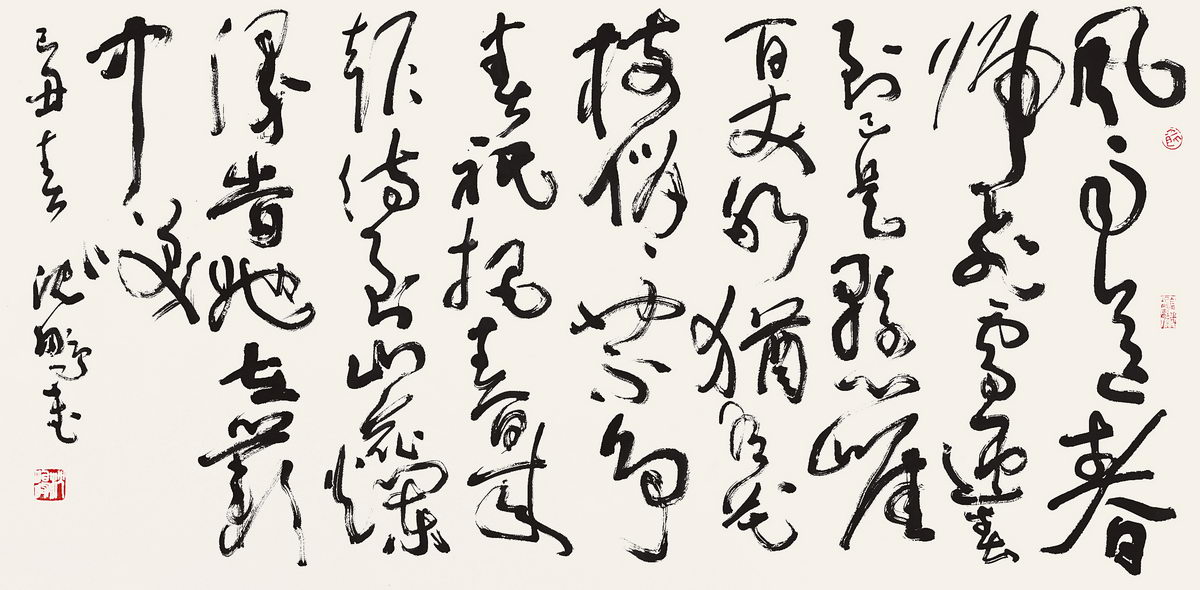 4. Collection and release of the whole article
4. Collection and release of the whole article
From point to line, from line to surface, and from surface to body, these are the basic elements of a calligraphy work. The criterion for good or bad depends on whether it can accurately, vividly and creatively express the author's thoughts, feelings, artistic style, Aesthetic concepts, in turn, impact readers’ vision with beauty, truth, and goodness, and shock readers’ hearts with ideals. Let them naturally generate certain associations and imaginations based on their own life and art accumulation, and gain beautiful artistic enjoyment. Such crazy cursive calligraphy works can be said to be successful. If it can be remembered for a long time, it is a masterpiece. If it can be passed down from generation to generation, it is a masterpiece. In this sense, the test standard for whether the collection and release of Kuang cursive script is successful lies in this.
The collection and enlargement of the whole article mainly refers to the style and charm, that is, the overall artistic taste-exhibiting uniqueness, freshness, modernity, avant-garde, and advanced, the artistic characteristics of this and this family's cursive calligraphy. In general, it is the harmony, unity and uniqueness of the collection and expansion of the whole article. The points, lines and surfaces complement each other, the viewpoint is charming, the lines are vivid, the appearance is fresh, and the overall wonderful. Of course, the unity mentioned here is by no means synonymous with one face, nor is it a clone that eliminates individual beauty, nor is it a cookie-cutter printing. Rather, it is rich and colorful, each with its own style, and heart-warmingly unified and complete. Ink techniques, paper techniques, and mounting are also indispensable contents for collecting and releasing the whole article. -
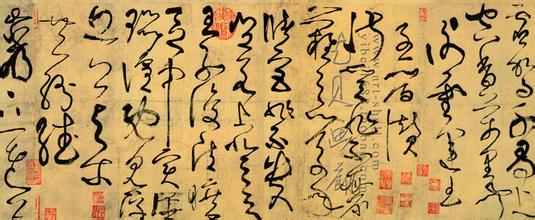
5. Collection and release of work content
The content of the work mainly includes three aspects: First, the text content. The second is the author’s level of cultural and artistic accomplishment. The third is the author’s emotional type. These three aspects are the main factors that determine whether the cursive calligraphy work can be used to its benefits and beauty, that is, the decisive factors. Of course, skilled, unique and comprehensive techniques based on inheritance and development are also indispensable basic conditions.
A. Text content. For cursive calligraphy works, choose text content that is romantic, rough, bold, intense, wide open, wide closed, with prominent expressions of joy, anger, sorrow, and joy, and obvious contrasts. It is more advantageous if you write your own poems and songs. At the same time, when choosing text content, the author should consciously or more based on the standpoint and habits of the readers, as well as the standpoint and habits of the nation. In this way, there will be an inexplicable and unexplained driving force for creation and appreciation. This is the "four or two moves" in terms of artistic effect. It is also a deeper calligraphy creation, that is, making full use of the artistic resources and artistic accomplishments of readers. Work together to complete the creation of a calligraphy work, thereby achieving the state of unity between the creator and the appreciator. In this way, it seems like a little, but it is actually a lot! This is because times have changed, and the function of cursive script has also changed. It is more ornamental, decorative and commercial. As a cursive calligrapher, it is necessary and necessary to actively choose some text content that is well-known to every household and known to women and children. This is not only a requirement of the laws of the market, but also a requirement of the laws of artistic creation and appreciation. The times require that Kuang cursive calligraphy works should come out of the history and current situation in study rooms and exhibition halls. Another reason is that the text content itself is suitable to be expressed in the form of cursive script, so it will naturally be easy to feel like a fish in water when writing, and it is also easy to reach the state of leveraging strength in Tai Chi.
B. The author’s degree of cultural and artistic accomplishment. A successful cursive calligraphy work is the crystallization of the author's cultural and artistic accomplishment. The higher the achievement of the work, the deeper and more comprehensive the author's cultural and artistic accomplishment. As a cursive calligrapher, his cultural and artistic accomplishments are multifaceted. For example: politics, economics, military, philosophy, aesthetics, music, sports, art, photography, the Internet... He does not have to be an expert in these areas, but he cannot not understand or not study , not cultivated. Crazy cursive calligraphers should also consciously watch rhythmic gymnastics, figure skating, air shows, NBA basketball games, ice hockey games, boxing, Sanda, modern dance...listen to piano music, violin music...and absorb the elements of the era of crazy cursive calligraphy, and even It’s inspiration, form, technique, etc. In short, crazy cursive calligraphers cannot just stay in the circle of calligraphy, be ignorant and know the method, practice the method, and use it. Otherwise, they will be limited by the method, blind to the method, and die from the method! Of course, this does not mean that one does not need to learn, study, or create techniques related to Kuang cursive calligraphy. On the contrary, all the cultural and artistic accomplishments of a Kuang cursive calligrapher are their "extra-poetry skills", which means they are free; they are all for the sake of their hearts. The "darling" of the work, the "princess" in the hand, is the collection.
C. The author’s emotional type. The author's thoughts and feelings are the soul of the work, throughout the ages. There is no work handed down from generation to generation that does not express the author's thoughts and feelings and become a masterpiece. The type of thoughts and feelings of a mad cursive calligrapher must have strong romanticism and idealism, especially when creating works. They forget other things and me, and the pen, ink, man and paper become one, almost crazy. His romance, his wildness, his unrestrainedness, his uninhibitedness, his frankness, his brightness, and his obsession and persistence in the art of cursive calligraphy are also very unique and even amazing in his daily life and life. Of course, he's not lacking in sense either, but he's just different again. If Zhang Xu and Huai Su didn't have the above-mentioned natural temperament, would they be able to become masters of cursive calligraphy? Can you write a book that will last forever? If Mao Zedong did not have the romanticism, idealism, broad-mindedness and genius of a mad cursive calligrapher, could he have written the "Recalling Qin'e·Loushanguan" that is full of smoke and earth-shattering ghosts and gods? In fact, the act of a mad cursive calligrapher is a real piece of mad cursive calligraphy. It is hard to imagine that a person who is timid, afraid of wolves and tigers, narrow-minded, eager for quick success, less passionate, less literary, and less coquettish can write successful cursive scripts. The thoughts and feelings of an excellent cursive calligrapher should be romantic, ideal, artistic, modern, and even avant-garde. Therefore, the collection and release in Kuang cursive calligraphy works is a natural expression and expression of the Kuang cursive calligrapher's thoughts, feelings, cultural and artistic accomplishments, and life realm. This is the test standard for whether the collection and release of Kuang cursive calligraphy is successful.
